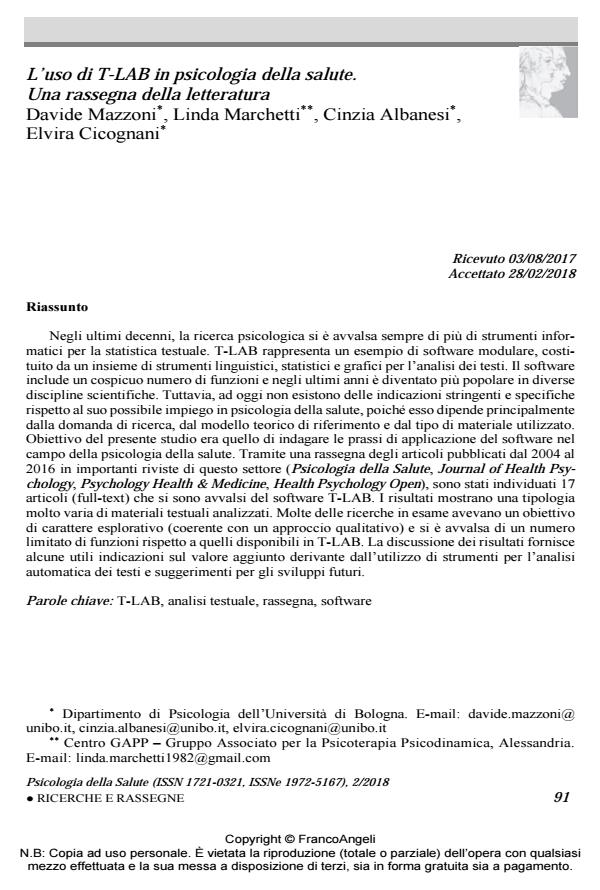The use of T-LAB in Health Psychology. A literature review
Journal title PSICOLOGIA DELLA SALUTE
Author/s Davide Mazzoni, Linda Marchetti, Cinzia Albanesi, Elvira Cicognani
Publishing Year 2018 Issue 2018/2
Language Italian Pages 24 P. 91-114 File size 261 KB
DOI 10.3280/PDS2018-002009
DOI is like a bar code for intellectual property: to have more infomation
click here
Below, you can see the article first page
If you want to buy this article in PDF format, you can do it, following the instructions to buy download credits

FrancoAngeli is member of Publishers International Linking Association, Inc (PILA), a not-for-profit association which run the CrossRef service enabling links to and from online scholarly content.
In the last decades, the psychological research has increased the use of informatic instruments for statistical textual analysis. T-LAB represents an example of modular software, made of a set of linguistic, statistical, and graphical instruments for textual analysis. The software includes a large number of tools and in the last years has become quite popular in different academic fields. However, precise and definite guidelines for its use in health psychology are still missing, because its use mostly depends on the research question, on the theoretical approach and from the data under analysis. The aim of the present study was to investigate praxis of application of this software in health psychology. Through a literature review of the articles which were published between 2004 and 2016 in important scientific journals (Psicologia della Salute, Journal of Health Psychology, Psychology Health & Medicine, Health Psychology Open), 17 contributions (full-text) using T-LAB were identified. Results showed a great variability in the textual materials under analysis. Many studies shared an exploratory aim (consistent with a qualitative approach) and adopted only few "popular" tools from the list that is available in T-LAB. The discussion of results provides useful implications about the possible advantages deriving from the use of statistical textual analysis and suggestions for the future.
Keywords: T-LAB, textual analysis, literature review, software
- Coping with systemic lupus erythematosus in patients’ words Alain Cornet, Davide Mazzoni, Angela Edwards, Dario Monzani, Gabriella Pravettoni, Jeanette Andersen, Marta Mosca, in Lupus Science & Medicine /2022 pp.e000656
DOI: 10.1136/lupus-2022-000656 - 100 días de pandemia: narrativas de los think tanks en el inicio de la Covid-19 Vanessa Roger-Monzó, Fernando Castelló-Sirvent, in European Public & Social Innovation Review /2024 pp.1
DOI: 10.31637/epsir-2024-735 - Ten Years of Idiographic Science Alfonso Santarpia, pp.143 (ISBN:979-8-88730-028-3)
- The cultural representations and symbolizations emerging from Italian psychologists working in multidisciplinary assisted reproduction teams: A linguistic analysis with the emotional text mining Michela Di Trani, Roberta Spoletini, Alessia Renzi, Silvia Monaco, Fabiola Fedele, Giulia Scaravelli, in Journal of Health Psychology /2025 pp.528
DOI: 10.1177/13591053241251528 - Novel Coronavirus Outbreak and Career Development: A Narrative Approach Into the Meaning for Italian University Graduates Anna Parola, in Frontiers in Psychology 2255/2020
DOI: 10.3389/fpsyg.2020.02255 - Attitudes toward the use of ChatGPT to seek oncological information: a qualitative study Ilaria Durosini, Marianna Agnese Masiero, Milija Strika, Davide Mazzoni, Gabriella Pravettoni, in Frontiers in Psychology 1644323/2025
DOI: 10.3389/fpsyg.2025.1644323 - Lavorare in centri per uomini violenti affrontandone l'invisibilità della violenza Fortuna Procentese, Immacolata Di Napoli, Caterina Arcidiacono, Marina Cerqua, in PSICOLOGIA DELLA SALUTE 3/2019 pp.123
DOI: 10.3280/PDS2019-003007 - The Body after Cancer: A Qualitative Study on Breast Cancer Survivors’ Body Representation Valeria Sebri, Ilaria Durosini, Davide Mazzoni, Gabriella Pravettoni, in International Journal of Environmental Research and Public Health /2022 pp.12515
DOI: 10.3390/ijerph191912515 - Medical Students and Professionals Facing the COVID-19 Pandemic: A Cross-Sectional Survey Study about Similarities and Differences Giacomo De Micheli, Giulia Marton, Davide Mazzoni, Laura Vergani, in Behavioral Sciences /2022 pp.189
DOI: 10.3390/bs12060189
Davide Mazzoni, Linda Marchetti, Cinzia Albanesi, Elvira Cicognani, L’uso di T-LAB in psicologia della salute. Una rassegna della letteratura in "PSICOLOGIA DELLA SALUTE" 2/2018, pp 91-114, DOI: 10.3280/PDS2018-002009